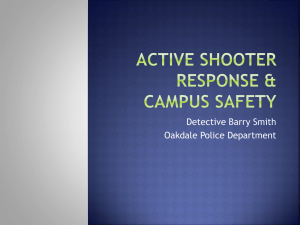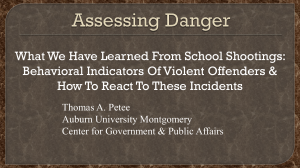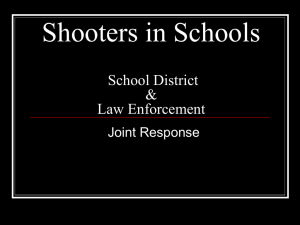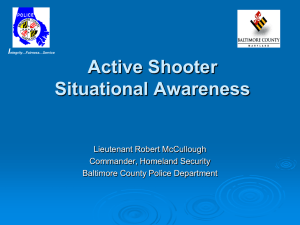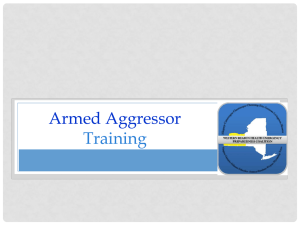Active Shooters: Lessons Learned & Useful
advertisement
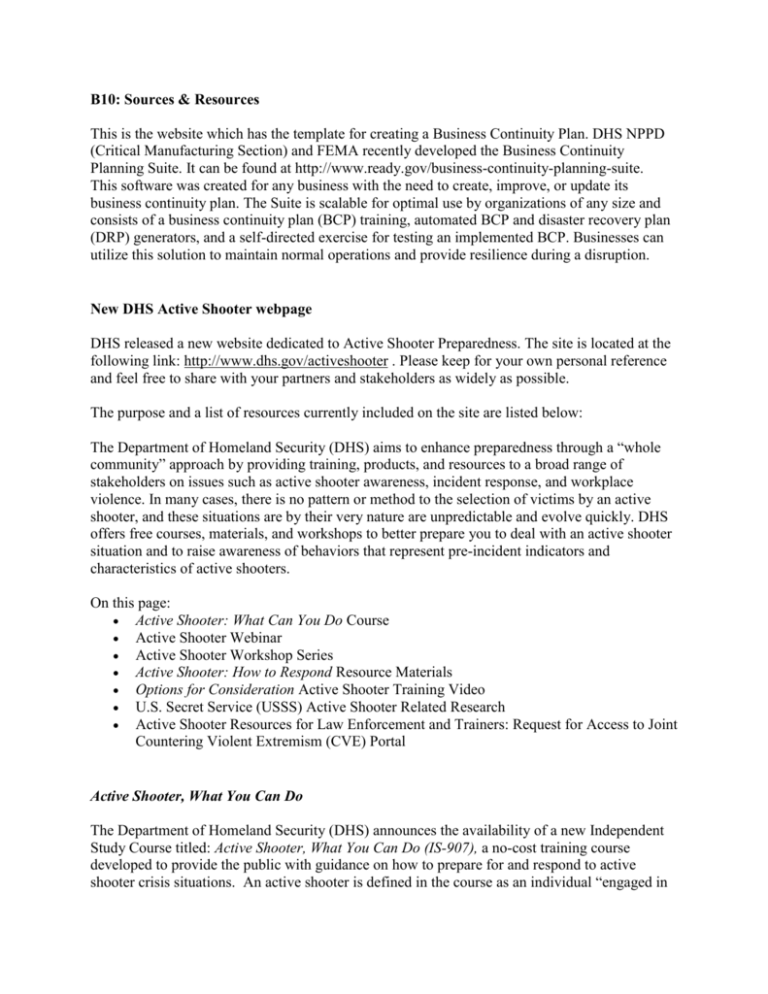
B10: Sources & Resources This is the website which has the template for creating a Business Continuity Plan. DHS NPPD (Critical Manufacturing Section) and FEMA recently developed the Business Continuity Planning Suite. It can be found at http://www.ready.gov/business-continuity-planning-suite. This software was created for any business with the need to create, improve, or update its business continuity plan. The Suite is scalable for optimal use by organizations of any size and consists of a business continuity plan (BCP) training, automated BCP and disaster recovery plan (DRP) generators, and a self-directed exercise for testing an implemented BCP. Businesses can utilize this solution to maintain normal operations and provide resilience during a disruption. New DHS Active Shooter webpage DHS released a new website dedicated to Active Shooter Preparedness. The site is located at the following link: http://www.dhs.gov/activeshooter . Please keep for your own personal reference and feel free to share with your partners and stakeholders as widely as possible. The purpose and a list of resources currently included on the site are listed below: The Department of Homeland Security (DHS) aims to enhance preparedness through a “whole community” approach by providing training, products, and resources to a broad range of stakeholders on issues such as active shooter awareness, incident response, and workplace violence. In many cases, there is no pattern or method to the selection of victims by an active shooter, and these situations are by their very nature are unpredictable and evolve quickly. DHS offers free courses, materials, and workshops to better prepare you to deal with an active shooter situation and to raise awareness of behaviors that represent pre-incident indicators and characteristics of active shooters. On this page: Active Shooter: What Can You Do Course Active Shooter Webinar Active Shooter Workshop Series Active Shooter: How to Respond Resource Materials Options for Consideration Active Shooter Training Video U.S. Secret Service (USSS) Active Shooter Related Research Active Shooter Resources for Law Enforcement and Trainers: Request for Access to Joint Countering Violent Extremism (CVE) Portal Active Shooter, What You Can Do The Department of Homeland Security (DHS) announces the availability of a new Independent Study Course titled: Active Shooter, What You Can Do (IS-907), a no-cost training course developed to provide the public with guidance on how to prepare for and respond to active shooter crisis situations. An active shooter is defined in the course as an individual “engaged in killing or attempting to kill people in a confined and populated area. In most cases, there is no pattern or method to their selection of victims.” This new online training is available through the Federal Emergency Management Agency (FEMA) Emergency Management Institute (EMI) at http://training.fema.gov/EMIWeb/IS/IS907.asp The training is targeted to reach a broad range of individuals, including managers and employees, so they can prepare to respond to an active shooter situation. The Active Shooter course was developed by the Office of Infrastructure Protection through a collaborative process that included representatives from the Commercial Facilities Sector and FEMA EMI. Development also included consultation with the Federal Law Enforcement Training Center. The course is self-paced and takes about 45 minutes to complete. Upon completion of Active Shooter, What You Can Do, employees and managers will be able to: Describe the actions to take when confronted with an active shooter and responding law enforcement officials. Recognize potential workplace violence indicators. Describe actions to take to prevent and prepare for potential active shooter incidents. Describe how to manage the consequences of an active shooter incident. A certificate from FEMA EMI is awarded to participants who complete the course and pass a short final exam. This is the second in a series of critical infrastructure cross-sector training courses; DHS announced the availability of IS-906, Workplace Security Awareness, in early March. Access IS906 on the FEMA EMI Web site: http://training.fema.gov/EMIWeb/IS/IS906.asp. For more information about Office of Infrastructure Protection training courses, contact: IP_Education@hq.dhs.gov. For more information on DHS critical infrastructure protection and resilience programs visit: www.dhs.gov/criticalinfrastructure. NEW DHS TRAINING COURSE AVAILABLE: “SURVEILLANCE AWARENESS: WHAT YOU CAN DO” The Department of Homeland Security (DHS) just announced the availability of a new Independent Study Course titled, Surveillance Awareness: What You Can Do (IS-914), a nocost training course developed to provide awareness to critical infrastructure employees of actions to take to detect and deter hostile surveillance situations. This course provides guidance to individuals, including managers and employees, on ways to enhance critical infrastructure protection through increased awareness, detection and reporting of suspicious behavior that may be linked to hostile surveillance activities. This training is available at http://training.fema.gov/EMIWeb/IS/is914.asp The target audience for this course is all critical infrastructure employees, including managers and employees who may have little to no physical or operations security background knowledge. The Surveillance Awareness: What You Can Do course was developed by the National Protection and Program Directorate’s (NPPD) Office of Infrastructure Protection (IP), through a collaborative process that included representatives from the Sector Outreach and Partnership Division (SOPD), the Office of Bombing Prevention (OBP), and Private Sector Industry Subject Matter Experts (SMEs). The course is self-paced and takes approximately 45 minutes to complete. Upon completion of Surveillance Awareness: What You Can Do, critical infrastructure employees and managers will be able to: • Identify assets that may be of interest to adversaries • Recognize indicators of hostile surveillance within the everyday environment • Identify steps that employees can take to detect potential hostile surveillance incidents • Describe the importance of identifying and reporting suspicious activities associated with surveillance • Specify actions employees can take to report potential hostile surveillance incidents A certificate from FEMA is awarded to participants who complete the course and pass a short final exam.
